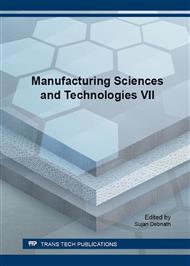[1]
MPOB. Review of annual production of oil palm products: 1975–2005 (tonnes). Malaysian Palm Oil Board (MPOB). http: /econ. mpob. gov. my/economy/Production1 (accessed July 9, 2009).
DOI: 10.17576/jkukm-2021-33(1)-12
Google Scholar
[2]
H. Pan, Z. F. Zheng, C. Y. Hse, Microwave-assisted liquefaction of wood with polyhydric alcohols and its application in preparation of polyurethane (PU) foams. Eur. J. Wood Wood Prod. 2012, 70, 461–470.
DOI: 10.1007/s00107-011-0567-6
Google Scholar
[3]
J. M. Xu, J. C. Jiang, C. Y. Hse, and T. F. Shupe, (2012). Renewable chemical feedstocks from integrated liquefaction processing of lignocellulosic materials using microwave energy, Green Chemistry 14(10), 2821-2830.
DOI: 10.1039/c2gc35805k
Google Scholar
[4]
J. L. Xie, J. Q. Qi, C. Y. Hse, T. F. Shupe, Effect of lignin derivatives in the bio-polyols from microwave liquefied bamboo on the preparation of polyurethane foams. Bioresources 2013, 9, 578–588.
DOI: 10.15376/biores.9.1.578-588
Google Scholar
[5]
F. G. Chen, Z. M. Lu, Liquefaction of wheat straw and preparation of rigid polyurethane foam from the liquefaction products. J. Appl. Polym. Sci. 2009, 111, 508–516.
DOI: 10.1002/app.29107
Google Scholar
[6]
F. G. Chen, Z. M. Lu, 2009: Liquefaction of wheat straw and preparation of rigid polyurethane foam from the liquefaction products. Journal of Applied Polymer Science 111(1): 508-516.
DOI: 10.1002/app.29107
Google Scholar
[7]
S. Pu, N. Shiraishi, 1994: Liquefaction of wood without a catalyst iv: effect of additives, such as acid, salt, and neutral organic solvent. Mokuzai Gakkaishi 40(8): 824-829.
Google Scholar
[8]
S. H. Lee, Y. Teramoto, N. Shiraishi, Acid-catalyzed liquefaction of waste paper in the presence of phenol and its application to novolak-type phenolic resin. J. Appl. Polym. Sci. 2002, 83, 1473–1481.
DOI: 10.1002/app.10038
Google Scholar
[9]
W. Hoareau, W. G. Trindade, B. Siegmund, A. Castellan, E. Frollini, Sugar cane bagasse and curaualignins oxidized by chlorine dioxide and reacted with furfuryl alcohol: Characterization and stability. Polym. Degrad. Stab. 2004, 86, 567–576.
DOI: 10.1016/j.polymdegradstab.2004.07.005
Google Scholar
[10]
M. Schwanninger, J. C. Rodrigues, H. Pereira, B. Hinterstoisser, Effects of short-time vibratory ball milling on the shape of FT-IR spectra of wood and cellulose. Vib. Spectrosc. 2004, 36, 23–40.
DOI: 10.1016/j.vibspec.2004.02.003
Google Scholar
[11]
J. X. Sun, F. C. Cao, X. F. Sun, R. C. Sun, Comparative study of hemicellulose isolated with alkaline peroxide from lignocellulosic materials. J. Wood Chem. Technol. 2005, 24, 239–262.
DOI: 10.1081/wct-200038170
Google Scholar
[12]
S. Karagöz, T. Bhaskar, A. Muto, Y. Sakata, M. A. Uddin, 2004. Low-temperature hydrothermal treatment of biomass: effect of reaction parameters on products and boiling point distributions. Energy Fuels 18, 234–241.
DOI: 10.1021/ef030133g
Google Scholar
[13]
H. Pan. Synthesis of polymers from organic solvent liquefied biomass: A review. Renewable and Sustainable Energy Reviews, 15: 3454 3463, May (2011).
DOI: 10.1016/j.rser.2011.05.002
Google Scholar


